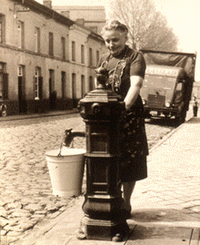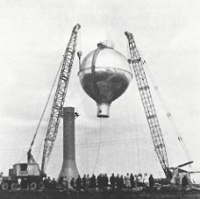History
 The history of water supply in Flanders dates back to the 17th and 18th centuries, when typhus and cholera claimed thousands of lives in our regions. This was also driven by the increasing industrialisation and the associated contamination of well and river water, in combination with poor hygiene.
The history of water supply in Flanders dates back to the 17th and 18th centuries, when typhus and cholera claimed thousands of lives in our regions. This was also driven by the increasing industrialisation and the associated contamination of well and river water, in combination with poor hygiene.
The then French government, which had conquered Belgium at the end of the 18th century, therefore decided to take action. The decree of 14 December 1789 and the laws of 16 and 24 August 1790 required the municipalities to take measures towards preventing epidemics and livestock diseases. The government thus shifted the responsibility for public drinking water to the municipalities. The Belgian government enshrined this responsibility in the Municipal Act in 1836.
Nationale Maatschappij der Waterleidingen (National Water Company)
In practice, this Act was hardly ever implemented. The majority of municipalities in fact lacked the financial resources and technical know-how to fulfil this mission. It is therefore not surprising that the industrialised cities were the first to proceed with the construction of municipal water distribution systems - Brussels (1858), Liege (1863), Verviers (1878)..., - driven mainly by economic considerations. In rural areas, by contrast, there were hardly any municipal initiatives. This led the government in 1907 to create the possibility of establishing intermunicipal companies for water distribution. This resulted in the creation of, among others, the Provincial and Intermunicipal Drinking Water Company of the Province of Antwerp (PIDPA) and the Intermunicipal Company of Flanders for Water Supply (TMVW).
 When 6 years later these, too, were found not to produce the desired result, the government decided to take action itself. In 1913, the National Water Company (NMDW) was established by law. Its remit was to intervene in those areas where no municipal initiative was forthcoming. The historical mission of the NMDW was to supply sufficient, high-quality and affordable drinking water, also in the remotest regions of the country.
When 6 years later these, too, were found not to produce the desired result, the government decided to take action itself. In 1913, the National Water Company (NMDW) was established by law. Its remit was to intervene in those areas where no municipal initiative was forthcoming. The historical mission of the NMDW was to supply sufficient, high-quality and affordable drinking water, also in the remotest regions of the country.
The first Flemish municipalities to join the NMDW included Eeklo, Aarschot and a number of municipalities in southeast Limburg. At the start of World War II, 180 municipalities had joined the NMDW. The NMDW experienced rapid growth, especially after World War II. In 1950, 293 municipalities were members of the NMDW and 1.2 million customers were supplied by the NMDW. In 1970, the NMDW had 3.8 million customers, almost exclusively in rural municipalities and smaller towns that did not have the financial resources to organise their own hygienic water supply.
Vlaamse Maatschappij voor Watervoorziening (Flemish Water Supply Company) cvba
As part of the state reform of 1980, the authority for the supply of drinking water was passed on to the regions. The NMDW's task was taken over by new companies: the Société Wallonne des Eaux (Walloon Water Distribution Company, SWDE) for the Walloon Region and the Vlaamse Maatschappij voor Watervoorziening (Flemish Water Distribution Company, VMW) for the Flemish Region. The VMW was established by decree of 28 June 1983 as a limited liability cooperative partnership. The capital was provided by the Flemish Region, the provinces of Brabant, Limburg, Antwerp, East Flanders and West Flanders, and by the affiliated municipalities.
The Government of Flanders approved the VMW's articles of association on 17 July 1985. The amendments were approved by decision of 21 April 1993. From 1987, the VMW de facto assumed the rights and obligations of the NMDW for the Flemish part of the country.
De Watergroep
Over the past century we have evolved from a traditional drinking water company to an integrated water company providing services throughout the entire water chain. In addition to drinking water, the focus in recent years has been increasingly on wastewater and industrial water. As a result, the name 'Flemish Water Supply Company' was no longer accurate and in 2013 it was changed to 'De Watergroep' (The Water Group), together with a new mission: We supply a range of customised water solutions. Today, for tomorrow’s generation.
